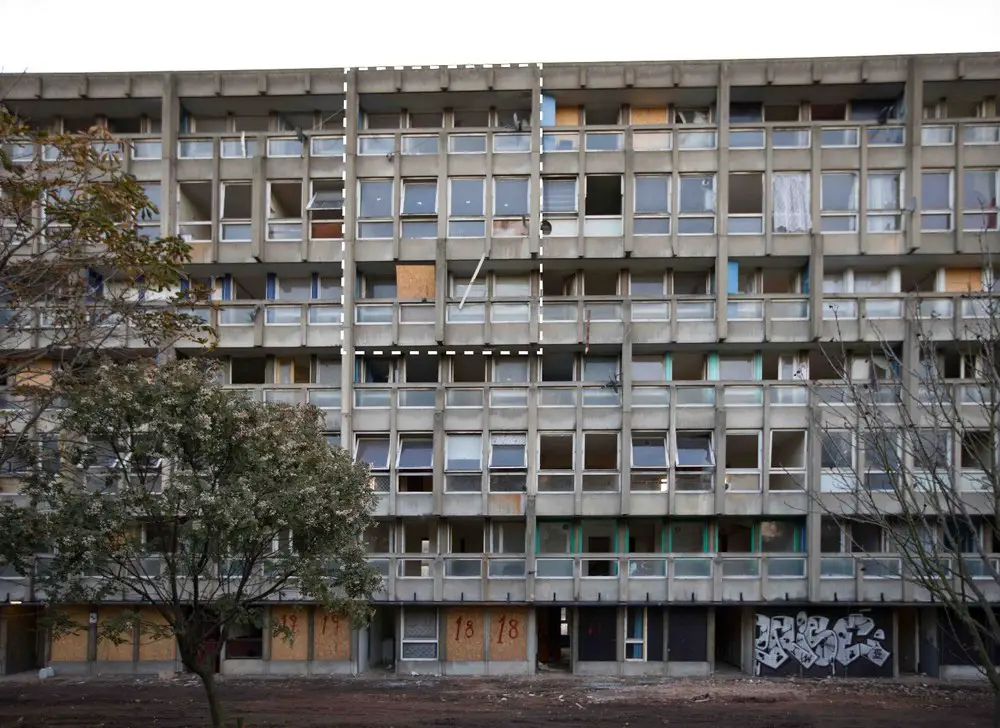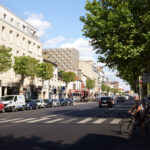Robin Hood Gardens: A Ruin in Reverse at the Applied Arts Pavilion Venice Architecture Biennale
Robin Hood Gardens: A Ruin in Reverse, Venice
Architecture Exhibition in Italy – Curators, Dates, News
23 May 2018
Robin Hood Gardens: A Ruin in Reverse at the Applied Arts Pavilion
Robin Hood Gardens: A Ruin in Reverse at the Applied Arts Pavilion, Venice Biennale 2018
Special Project Applied Arts Pavilion at the Biennale Architettura 2018
jointly organized by
La Biennale di Venezia and the Victoria and Albert Museum, London
Collaboration between the two institutions renewed for the third consecutive year
La Biennale di Venezia and the Victoria and Albert Museum, London present:
Robin Hood Gardens: A Ruin in Reverse
curated by Christopher Turner and Olivia Horsfall Turner
V&A has commissioned Korean artist Do Ho Suh to document the architecture and interiors of the internationally recognised London estate currently under demolition
Sale d’Armi A, Arsenale
26 May – 25 November 2018
Inauguration | 25 May, 2:30pm
For the third consecutive year, the collaboration between La Biennale di Venezia and the Victoria and Albert Museum, London has made it possible to present a Special Project jointly organised by the two institutions.
Robin Hood Gardens, completed 1972, designed by Alison and Peter Smithson:
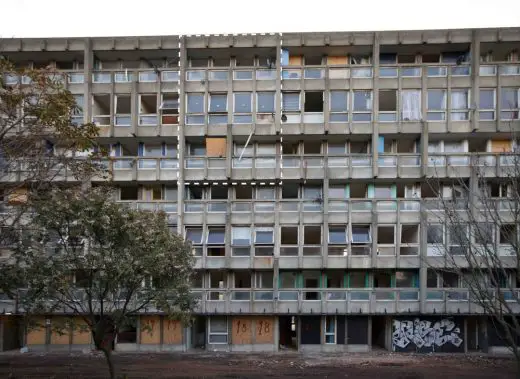
photo © The Victoria and Albert Museum, London
Robin Hood Gardens: A Ruin in Reverse is the title of the exhibition curated by Christopher Turner and Olivia Horsfall Turner at the Applied Arts Pavilion in the Sale d’Armi Arsenale.
Responding to this year Architecture Biennale’s theme of FREESPACE, the exhibition Robin Hood Gardens: A Ruin in Reverse presents a 9m-high salvaged section of the façade of Robin Hood Gardens, the Brutalist housing estate by Alison and Peter Smithson currently under demolition. A specially commissioned installation by Do Ho Suh shows a panoramic portrait of the architecture and interiors of the condemned 1972 estate.
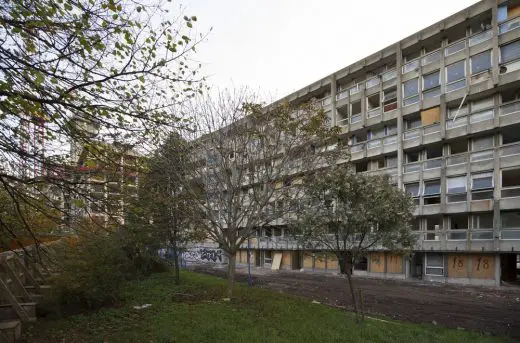
photo © The Victoria and Albert Museum, London
Through archival film and images, the exhibition also explores the utopian vision of the Smithsons, and in documentary interviews architects, critics and residents offer their analysis of the estate’s legacy and offer their ideas on the future of social housing.
In 2017, just before demolition of the estate began, the V&A decided to save and preserve a three- storey section of each façade and the interior fittings of two flats. The resulting fragment will take its place in the V&A’s national collection of architecture as an internationally significant example of Brutalism.
Robin Hood Gardens was the culmination of twenty years of research into social housing by Alison Smithson (1928-1993) and Peter Smithson (1923-2003). They intended it to be ‘a demonstration of a more enjoyable way of living … a model, an exemplar, of a new mode of urban organisation.’ Less than fifty years later, the building is being demolished, having controversially been denied protection by listing, and will be replaced by a £300m redevelopment of affordable and private housing.
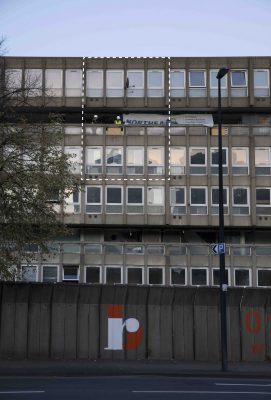
photo © The Victoria and Albert Museum, London
This is not the first time that Robin Hood Gardens has featured at La Biennale di Venezia. In 1976, in the 37th International Art Exhibition, the Smithsons’ exhibition ‘Sticks and Stones’ included a billboard-size photograph of Robin Hood Gardens shortly after completion and a bench based on one of the concrete columns that articulate the façade of the building.
‘A building under assembly is a ruin in reverse’ they wrote. Now that the ‘ruin in reverse’ has become a real ruin, what lessons can we learn from its ideals and fate? In the context of unprecedented urban pressures and the redevelopment of numerous post-war housing projects, what is the future of social housing?
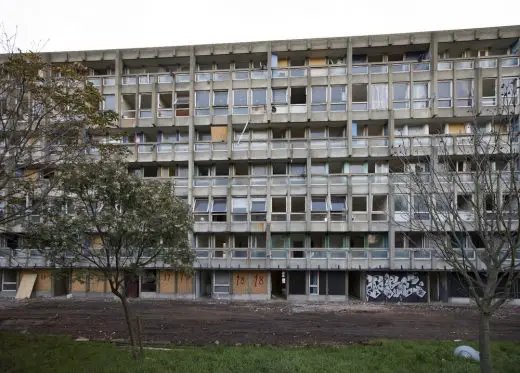
photo © The Victoria and Albert Museum, London
Further details
Outside the Pavilion of Applied Arts, three storeys of the original façade, weighing approximately eight tons, have been reassembled on a scaffold designed by ARUP, who engineered the original building, with muf architecture/art, who first proposed the V&A’s acquisition of the fragment. This structure allows visitors to stand on an original section of a ‘street in the sky’ – the elevated access deck designed by the Smithsons to foster interaction between neighbours and promote community.
Inside the pavilion, the V&A has commissioned a new work by Korean artist Do Ho Suh, whose practice is centred on the idea of home as both a physical structure and a lived experience. Suh’s panoramic film is both site-specific and time-specific – a document of the Smithson’s modular interiors as they have been adapted, decorated and furnished by residents.
It is also a wider meditation on home, memory and displacement within a physical structure that is on the verge of demolition, less than fifty years after the architects’ utopian vision was completed. Suh has used time-lapse photography, drone footage, 3D-scanning and photogrammetry to create a visual journey in which the camera pans vertically and horizontally through the building, moving seamlessly from one space to another to reveal individual lives within the modular plan.
The work responds to the indistinct boundaries between psychic interior and objective exterior, while reflecting on these homes and their meaning within a physical structure that is about to disappear.
The subject of this year’s exhibition arises not only from the V&A’s collection of the fragment of Robin Hood Gardens, but also responds to the theme for the Biennale Architettura 2018 of FREESPACE, which, in the words of Irish architects and curators Yvonne Farrell and Shelley McNamara, “encourages reviewing ways of thinking, new ways of seeing the world, of inventing solutions where architecture provides for the wellbeing and dignity of each citizen of this fragile planet.”
Slides of interiors circa 1970, by Peter Smithson:
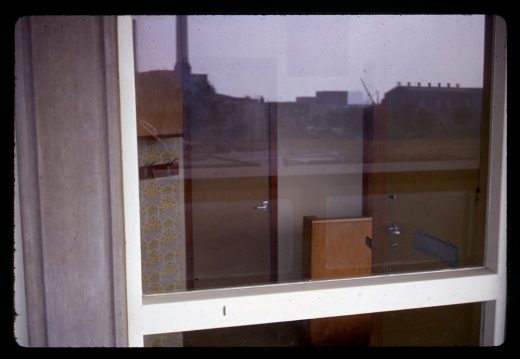
photo Courtesy of The Smithson Family Collection
Paolo Baratta, President of La Biennale di Venezia stated: “The Pavilion of Applied Arts within the Biennale of Art and Architecture is a joint initiative by La Biennale di Venezia and the V&A. According to the agreement, this year it will host an installation curated by the V&A.
In the spirit of the Biennale Architettura and of its theme “free space” it emphasises the danger of making choises that ends up with an undesired free space in form of a hole, i.e. of an empty space. It is a useful reminder that heritage is not necessarily what we have inherited but also what we have done and consider significant.”
Dr Tristram Hunt, Director of the V&A said: “We are proud to continue our innovative relationship with La Biennale di Venezia and its formation remains one of Dr Martin Roth’s great achievements during his directorship of the V&A. Robin Hood Gardens: A Ruin In Reverse asks the questions that face all of us about the future of social housing.”
Dr Christopher Turner and Dr Olivia Horsfall Turner, Curators of the 2018 Pavilion of Applied Arts, said: “The V&A has a long-standing history of collecting large-scale architectural fragments, often salvaged from demolition sites. These include the sixteenth-century façade of Sir Paul Pindar’s house in Bishopsgate, demolished in 1890, and the eighteenth-century music room rescued from the 1938 demolition of Norfolk House in St James’s Square.
The case of Robin Hood Gardens is arresting because it embodied such a bold vision for housing provision yet under fifty years after its completion it is being torn down. Out of the ruins of Robin Hood Gardens, we want to look again at the Smithson’s original ideals and ask how they can inform and inspire current thinking about social housing.”
Social networks
Facebook: La Biennale di Venezia|Twitter: @la_Biennale|Instagram: labiennale
Facebook: victoriaandalbertmuseum|Twitter: @V_and_A|Instagram: vamuseum|Pinterest: vamuseum
Official hashtag:
#BiennaleArchitettura2018 #Freespace #RobinHoodGardens #RuininReverse
Promoters
La Biennale di Venezia with the Victoria and Albert Museum, London
Curators
Dr Christopher Turner
Dr Olivia Horsfall Turner
Project Manager
Alexandra Willett
Research
Esme Hawes
Exhibition designers
the design kollektiv
Installation of Robin Hood Gardens fragment
muf architecture/art
Arup
Film/animation installation
Do Ho Suh
Documentary film
Thomas Beyer and Adrian Dorschner
Realised by La Biennale di Venezia
With the additional support of:
Volkswagen Group
Donors to the Venice Architecture Biennale Fund in memory of Dr Martin Roth
Swan Group
London Borough of Tower Hamlets
Mayor of London
Film/animation installation by Do Ho Suh supported by
Lehmann Maupin, New York, Hong Kong, and Seoul
Victoria Miro, London / Venice
Artemide kindly provided the exhibition lighting system
Venue: Sale d’Armi A, Arsenale, Sestiere Castello, Campiello Tana 2169/F, 30122 – Venezia, Italy
About La Biennale di Venezia
La Biennale di Venezia was founded in 1895 and is now one of the most famous and prestigious cultural organizations in the world. Paolo Baratta has been its President since 2008 and before that from 1998 to 2001.
La Biennale, who stands at the forefront of research and promotion of new contemporary art trends, organizes exhibitions and research in all its specific departments: Arts (1895), Architecture (1980), Cinema (1932), Dance (1999), Music (1930), and Theatre (1934). Its history is documented at the Historical Archives (ASAC) that has been completely renovated in recent years. The Art and Architecture Biennale have been recognized as the world leaders in contemporary exhibitions and has also been recognised as the best in the world. www.labiennale.org
About the V&A
The V&A is the world’s leading museum of art, design and performance with collections unrivalled in their scope and diversity. It was established to make works of art available to all and to inspire British designers and manufacturers. Today, the V&A’s collections, which span over 5,000 years of human creativity in virtually every medium and from many parts of the world, continue to intrigue, inspire and inform. www.vam.ac.uk
About the V&A’s Department for Design, Architecture and Digital
The Department for Design, Architecture and Digital promotes the study of contemporary design and architecture and its impact on society. It also stimulates new modes of collection, curation and public engagement. The department is responsible for the V&A’s Rapid Response Gallery, which displays items collected as evidence of social, political and economic change, forming a permanent legacy of objects that represent the world we live in today.
As the home of the national collection of architecture, the V&A holds monumental plastercasts, largescale architectural fragments and entire historic rooms as well as models, drawings and sketchbooks by major British and international architects.
Robin Hood Gardens Acquisition
The V&A’s acquisition of Robin Hood Gardens has been made possible by partnership-working between the development partners, Swan Housing Association, London Borough of Tower Hamlets and the Mayor of London who have collaborated with the V&A and muf architecture/art in the removal.
Location: Giardini della Biennale, Castello 1260, 30122 Venezi, Italia
Venice Architecture
Venice Architecture Designs – chronological list
Venice Architecture Tours by e-architect
Vatican Pavilion at the Venice Architecture Biennale
Architects: Foster + Partners
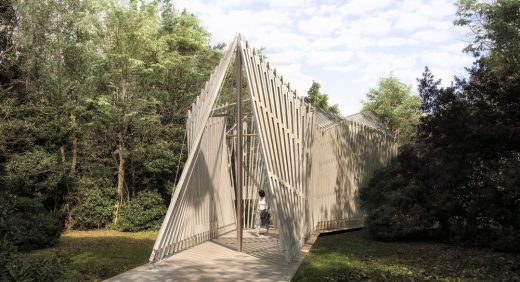
image courtesy of architects
Vatican Pavilion at the Venice Architecture Biennale
Venice Biennale Korean Pavilion 2018 by KECC
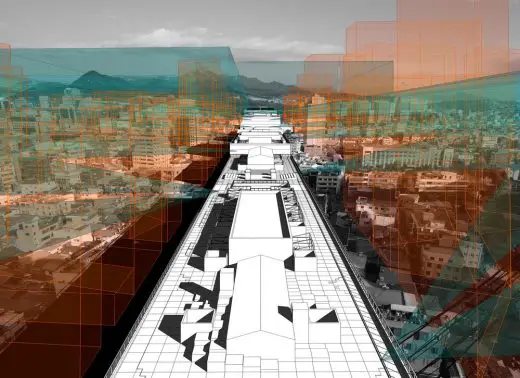
image © N.E.E.D. Architecture, Sungwoo Kim (N.E.E.D. Architecture)
Venice Biennale Korean Pavilion 2018
Venice Biennale Irish Pavilion 2018
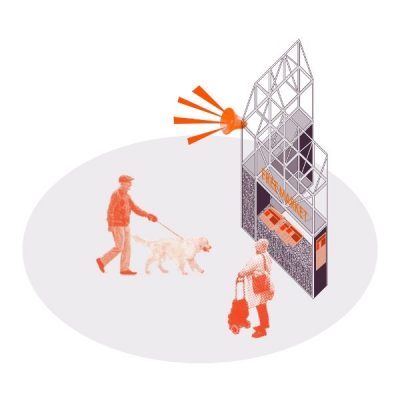
Illustration by Mark Wickham
Venice Biennale Irish Pavilion 2018
Pavilion of the Holy See at Venice Biennial
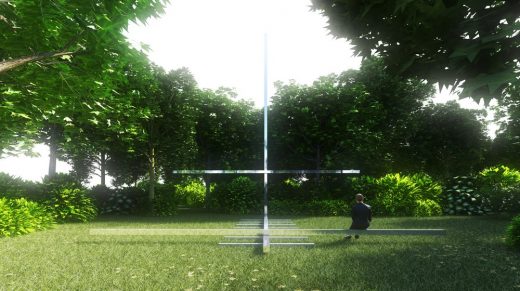
image courtesy of architects
Pavilion of the Holy See at Venice Biennial
British Pavilion at the 16th International Architecture Exhibition La Biennale di Venezia
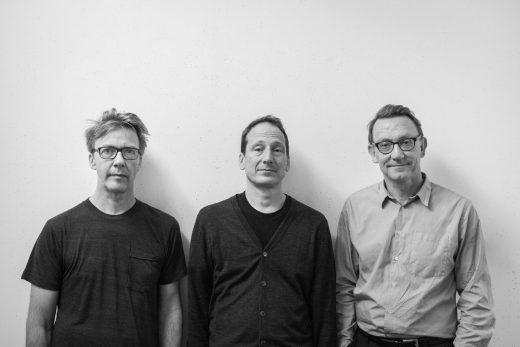
image courtesy of architects
British Pavilion Venice Biennale 2018 – Caruso St John Architects and artist Marcus Taylor
Venice Architecture Biennale – Review + Images
Website: La Biennale di Venezia
Comments / photos for the Robin Hood Gardens: A Ruin in Reverse at the Applied Arts Pavilion Venice Biennale 2018 page welcome

